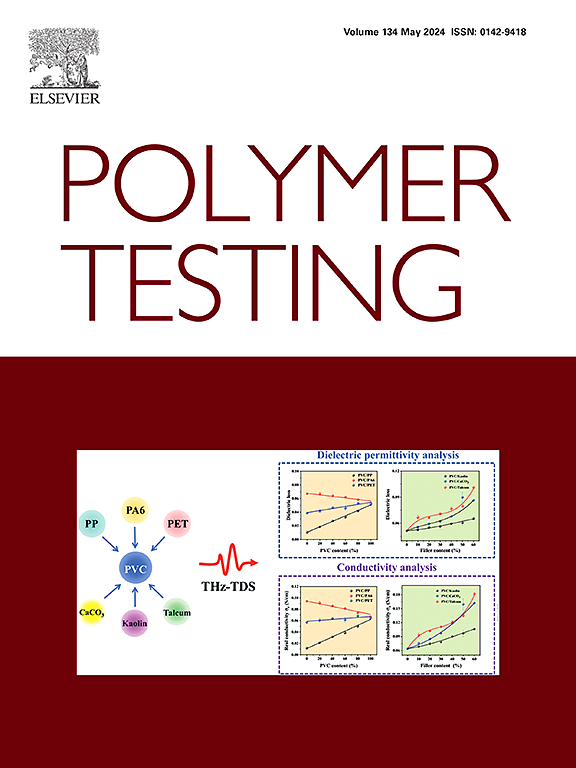用FTIR-ATR,非采样拉曼探针光谱和热重分析测试和分析鞋垫共聚物
IF 5
2区 材料科学
Q1 MATERIALS SCIENCE, CHARACTERIZATION & TESTING
引用次数: 0
摘要
制鞋业每年创造数千亿美元的收入。然而,电子商务、在线零售商市场和社交媒体平台促进了鞋类供应链上的跨境假冒,对鞋类生产商和营销人员产生了经济影响,降低了公司的销售额和利润率。本研究报告了首次将FTIR-ATR,非采样拉曼探针光谱和热重分析(TGA)结合使用,用于不同类别鞋类的共聚物分析。具体来说,通过捐赠或从当地商店购买收集了199个不同品牌的鞋子样品,包括高端鞋、低端鞋、高跟鞋、靴子、男士正装鞋、平底鞋和运动鞋,并进行了FTIR和拉曼光谱测量。收集聚乙酸乙烯酯ATEVA共聚物参考标准品的FTIR-ATR光谱和拉曼光谱,并利用其构建校准曲线。对ATEVA共聚物参考标准和鞋垫进行热重分析,评价聚合物的热分解和稳定性规律。品质因数(R2≥0.9542)表明校准曲线线性。在鞋跟、凉鞋、靴子、男正装鞋、平底鞋和运动鞋中分别测定了%共聚物的总体结果(15±5.2%、23±9.0%、21±9.0%、25±11%、19±8.2%和23±10%)。FTIR和拉曼光谱以及确定的%共聚物含量可以提供鞋垫热降解,稳定性和鞋垫耐久性的见解。鞋类聚合物的热像图分解能量各不相同,但鞋类鞋垫聚合物在600℃左右降解,随着温度的升高,重量继续逐渐减轻。这项研究发现了美国海关和边境保护局官员、法医科学家、执法人员和质量控制人员在法医鞋类、织物和汽车聚合物分析方面的实际应用,用于消费品标准符合性的质量检查。本文章由计算机程序翻译,如有差异,请以英文原文为准。
Testing and analysis of footwear insole copolymers by FTIR-ATR, non-sampling Raman probe spectroscopy, and thermal gravimetric analysis
The footwear industry generates hundreds of billions of dollars in revenue each year. However, e-commerce, online retailers' markets, and social media platforms have promoted footwear cross-border counterfeiting along the footwear supply chain with economic implications for shoe producers and marketers, lowering the company's sales and profit margins. This study reports the first combined use of FTIR-ATR, non-sampling Raman probe spectroscopy and Thermal Gravimetric Analysis (TGA) for copolymer analyses of different classes of footwear. Specifically, one hundred and ninety-nine (199) shoe samples of various brand names—including high-end shoes, low-end shoes, heels, boots, men's dress shoes, flats, and sneakers—were collected via donation or purchasing from local stores and subjected to FTIR and Raman spectra measurement. The FTIR-ATR and Raman spectra of poly (ethylene vinyl acetate) ATEVA copolymers reference standards were collected and utilized to construct calibration curves. ATEVA copolymers reference standards and the insole footwear were further subjected to TGA to evaluate the polymers' thermal decomposition and stability pattern. The figure-of-merit (R2 ≥ 0.9542) demonstrates the linearity of the calibration curve. The overall results (15 ± 5.2 %, 23 ± 9.0 %, 21 ± 9.0 %, 25 ± 11 %, 19 ± 8.2 %, and 23 ± 10 %) of % copolymer was determined in the heels, sandals, boots, men's dress shoes, flats, and sneakers respectively. The FTIR and Raman spectra and the determined % copolymers content may provide insight into footwear insole thermal degradation, stability, and insole durability. The thermogram decomposition energy of footwear polymers vary, but footwear insole polymers degrade around 600 °C, and weight loss continues gradually with an increase in temperature. This study finds practical applications by U.S. Customs and Border Protection officers, forensic scientists, law enforcement, and quality control officers for forensic footwear, fabric, and automobile polymer analysis for quality checks for consumer goods standard compliance.
求助全文
通过发布文献求助,成功后即可免费获取论文全文。
去求助
来源期刊

Polymer Testing
工程技术-材料科学:表征与测试
CiteScore
10.70
自引率
5.90%
发文量
328
审稿时长
44 days
期刊介绍:
Polymer Testing focuses on the testing, analysis and characterization of polymer materials, including both synthetic and natural or biobased polymers. Novel testing methods and the testing of novel polymeric materials in bulk, solution and dispersion is covered. In addition, we welcome the submission of the testing of polymeric materials for a wide range of applications and industrial products as well as nanoscale characterization.
The scope includes but is not limited to the following main topics:
Novel testing methods and Chemical analysis
• mechanical, thermal, electrical, chemical, imaging, spectroscopy, scattering and rheology
Physical properties and behaviour of novel polymer systems
• nanoscale properties, morphology, transport properties
Degradation and recycling of polymeric materials when combined with novel testing or characterization methods
• degradation, biodegradation, ageing and fire retardancy
Modelling and Simulation work will be only considered when it is linked to new or previously published experimental results.
 求助内容:
求助内容: 应助结果提醒方式:
应助结果提醒方式:


